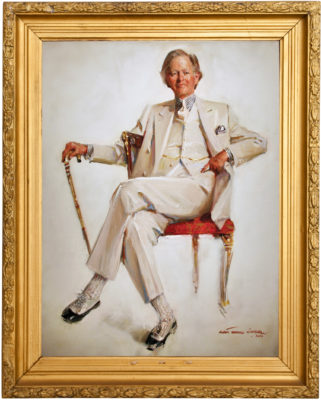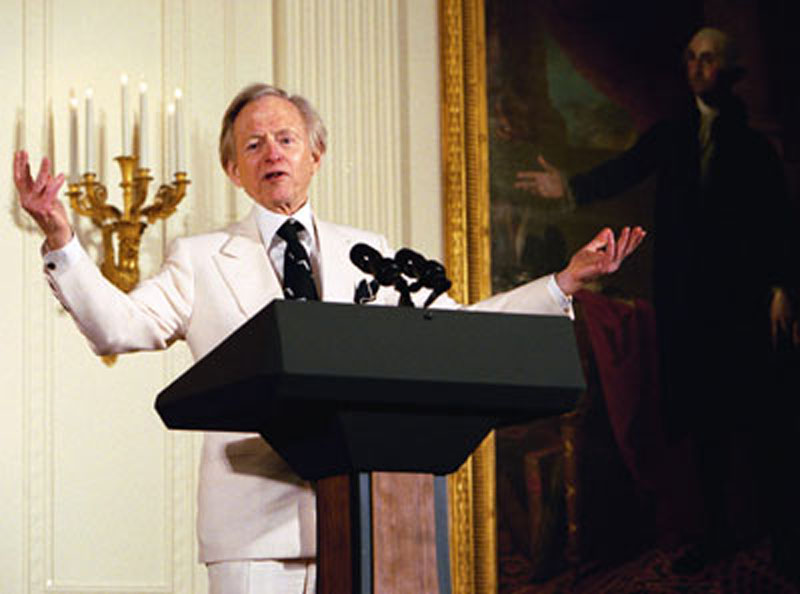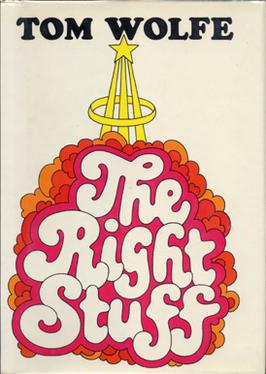 During my deplorably wasted youth, I found time to plow through the lyrical novels of Thomas Wolfe (1900-1938). Badgering friends constantly over my discovery, they would listen, pause and finally, muse, “Oh yeah. The fellow who wrote The Elected Kool Aid Acid Test.”
During my deplorably wasted youth, I found time to plow through the lyrical novels of Thomas Wolfe (1900-1938). Badgering friends constantly over my discovery, they would listen, pause and finally, muse, “Oh yeah. The fellow who wrote The Elected Kool Aid Acid Test.”
Ah, the Updike 1970s. At least people knew who Tom Wolfe was. They still do. Last week’s passing of Wolfe, the prolific journalist/novelist, marked yet another end of an era in American letters. It, too, was a time for celebration. Has America produced a more energetic, comical and insightful writer? From the “New Journalism” of the 1960s and ‘70s to the sweeping, comic novels of postmodern America, Wolfe broke new ground in everything he wrote, while leaving his legion of readers to wonder what this magician in the white suit would come up with next.
His genius? First of all, he was a reporter who jumped head first into the carnival of American life. Did American literature really need another novel about a college professor and his woman problems? No, feed that beast of American life and come back with that thick, 500 page-plus novel. Which Wolfe did time and time again.

Second, he was a most sly provocateur of American vanities. A native of Richmond, VA, a graduate of Washington and Lee and Yale, Wolfe loved to upend received wisdom. His books celebrated a world that American culture disdained: WASP stockbrokers, small town college girls, moonshiners, hell-for-leather jet pilots. Indeed, if American culture viewed the “WASP” as privileged and fit only as an object of scorn, Wolfe fired back with a hefty dose of comic ripostes. Junior Johnson, Chuck Yeager, John Glenn, Alan Shepard, Gordon Cooper, the fictional characters Sherman McCoy, Charlie Crocker and Charlotte Simmons: Want to pick a fight with any of them? The WASP not spoiled, but in fact the embodiment of the indomitable spirit that once made America.
Wolfe’s greatest non-fiction work—and one of the best books ever published by an American—was his 1980 stemwinder, The Right Stuff, about the once-legendary seven astronauts that made up the Mercury space program. Wolfe turned these rowdy fly boys into authentic American heroes. The stakes were enormous. In 1957, Russian shocked America with its Sputnik space shot. The reds, as American politicians reasoned, would now own the heavens and with it, have life and death domain over America. The bravery of these men—and even more so, their earth-bound spouses—was astounding. Test flight after test flight blew up on the Cape Canaveral launching pads. When Alan Shepherd attempted his 15-minute earth shot, commuters pulled over the side of the road to listen to the launch, fully expecting the luckless pilot to get blown up with his space ship.
Shepherd was a hero. So, too, was Chuck Yeager, the mountaineer who broke the speed of sound and especially, John Glenn, the “Presbyterian Pilot” who orbited the earth and won the space race for this fellow Americans.
 The Right Stuff was the perfect book for pre-Vietnam, still innocent America. The Bonfire of the Vanities, his 1986 debut novel, turned 1980s New York into a movable feast: Wall Street meets Park Avenue meets South Bronx. Rev. Bacon meets Sherman McCoy, a grand smash of people and money and power and ethnic groups that only the Big Apple could provide. As in his non-fiction, Wolfe championed the WASP as Sherman McCoy must graduate from his Wall Street millions to defending his manhood in a South Bronx courthouse following his implication in a hit-and-run accident.
The Right Stuff was the perfect book for pre-Vietnam, still innocent America. The Bonfire of the Vanities, his 1986 debut novel, turned 1980s New York into a movable feast: Wall Street meets Park Avenue meets South Bronx. Rev. Bacon meets Sherman McCoy, a grand smash of people and money and power and ethnic groups that only the Big Apple could provide. As in his non-fiction, Wolfe championed the WASP as Sherman McCoy must graduate from his Wall Street millions to defending his manhood in a South Bronx courthouse following his implication in a hit-and-run accident.
Wolfe’s other great theme was his ability to place the weight of the world on his heroes and heroines. There were the life and death travails of Yeager and Glenn. To me, Wolfe saved his two best characters for last: Charlotte Simmons, the earnest college freshman in I Am Charlotte Simmons and Nestor Camacho, the unsuspecting Miami police office in Back To Blood. Simmons must carry the expectations of her small western North Carolina logging town. The innocence of Wolfe’s characters living in lost innocence America is always pleasantly shocking. In her French literature class, the young Charlotte wonders why the novels of Flaubert and Balzac are in translation. After all, it’s French literature. Shouldn’t students read them in the original? Camacho, on the other hand, incurs the wrath of Miami’s politically active Cuban-American community once he dutifully rescues an asylum seeker at sea and returns him, as law mandates, back to Guantanamo, rather than to America and freedom. What did he do wrong? As with McCoy, both keep a true compass. Charlotte conquers the fictional DuPont College campus, dating the star basketball player. Camacho survives a suspension, remains on the force and finds a girlfriend, to boot.
The mortal man is now gone, but the books live. Nassau County has the best public library system in America. Go to any one of them, find a Wolfe title and crack it open. Dare you to put it down.



















